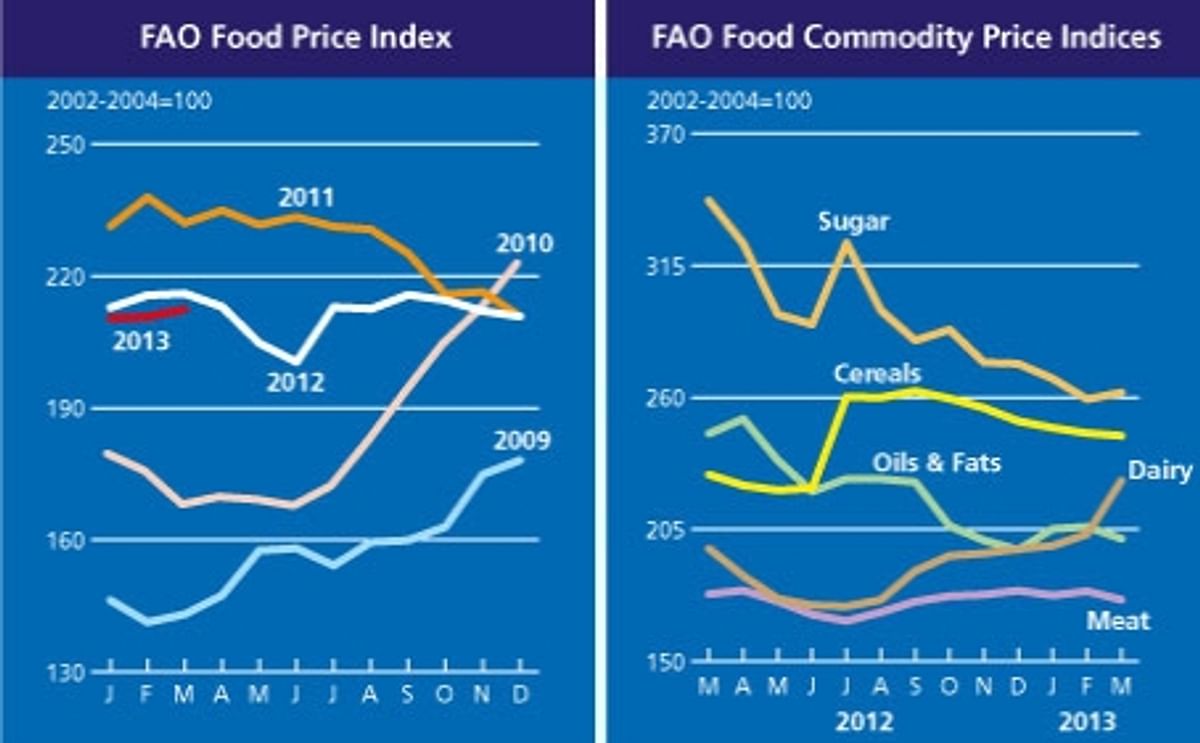The FAO Food Price Index averaged 212 points in March 2013, up 1 percent (1.7 points) from February, but 1.7 percent below March last year and nearly 11 percent below its peak in February 2011. The small increase in March was mainly the result of an 11 percent surge in the dairy sub-index, which carries a weight of 17 percent within the FAO Food Price Index. The changes in prices were more contained for the other commodity groups.
The FAO Cereal Price Index averaged 244 points in March, nearly unchanged from February. The index is 7 percent higher than in March 2012 but still 11 percent below its peak in April 2008. While maize quotations rose slightly last month, amid tightening exportable supplies in the United States, the increase was offset by sliding prices of wheat. Wheat prices fell initially on improved weather conditions in major growing regions but unseasonably cold temperatures resulted in sharp rebound during the second half of the month. On the other hand, rice prices remained generally unchanged, as falling prices in Asia were compensated by rising US quotations.
The FAO Oils/Fats Price Index averaged 201 points in March, down 5 points (2.5 percent) from February. The fall was mostly driven by soyoil prices, influenced by several factors: favourable weather conditions for soy in South America, expectations of a record 2013 US crop, the cancellation of large soybean orders by China and a slowdown in US crush demand. Meanwhile, palm oil prices dropped slightly, amid weakening export demand and ample stocks.
The FAO Dairy Price Index jumped by 22 points in March to 225, magnifying a rising trend initiated in August last year. The change in the index is one of the largest recorded. The index registered its highest value on record in November 2007 when it stood at 269 points, 19 percent above its current level.
At the root of the price surge is prolonged hot, dry weather in Oceania which has led to milk production falling off steeply and a concomitant reduction in the processing of dairy products. As a result, the spot prices for New Zealand dairy products – upon which the index is based – have surged, as buyers bid against each other to meet commitments. The “Oceania Effect”, has also caused export prices elsewhere to rise, but not to the same extent. The exceptional increase is in part a reflection of market uncertainty as buyers seek alternative sources of supply.
An additional factor is that producers have sought to differentiate their products within a general commodity category, such as Skimmed Milk Powder or Whole Milk Powder. Therefore, the size of the jump in prices is partly based in buyers seeking specific New Zealand products, at a time when production has unexpectedly declined and limited stocks are already committed. Furthermore, the Spring surge in milk production in Europe has been retarded due to unfavourable weather limiting pasture growth.
The FAO Meat Price Index averaged nearly 176 points in March, down 2 percent from February. Quotations for all types of meat moved lower – a reflection of adequate export supplies and a limited reduction in feed prices. Overall, the meat index has changed little in recent months and remains close to the same period last year. The cost of feed continues to be a prevailing concern to the industry.
The FAO Sugar Price Index averaged 262 points in March, up 2.8 points (1 percent) from February. The increase in prices reflected short-term supply disruption as a result of reported delays in loading sugar in the major ports of Brazil, the world’s largest sugar producer and exporter. However, prices were 80 points, or 23 percent, lower than in March 2012, reflecting the expected seasonal production surplus and large export availabilities.
Source: FAO
Primaire tabs
The FAO World Food Price Index up slightly in March on higher dairy prices

Like to receive news like this by email? Join and Subscribe!
Get the latest potato industry news straight to your WhatsApp. Join the PotatoPro WhatsApp Community!
Uitgelichte Bedrijven
Sponsored Content
Sponsored Content
Sponsored Content
Sponsored Content









